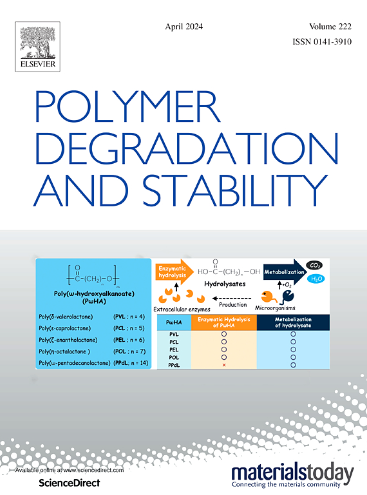Impact of mechanical reprocessing on degradation and performance of PA 11 and PA 11–LDPE blends
IF 7.4
2区 化学
Q1 POLYMER SCIENCE
引用次数: 0
Abstract
This study examines the mechanical recycling of a virgin PA 11 and a post-consumer PA 11–low density polyethylene (LDPE) (90/10) blend over ten reprocessing cycles. Fourier transform infrared spectroscopy (FTIR) and proton nuclear magnetic resonance (¹H NMR) analyses revealed changes in the intensity and position of specific absorption bands and proton signals, indicating progressive chain scission and molecular rearrangements. A carbonyl band was identified in the virgin PA 11 after reprocessing, a confirmation of thermo-oxidative degradation. Mechanical testing showed gradual reductions in elastic modulus, stress at break, and impact strength, with significant deterioration from the third cycle onward. Rheological analysis revealed consistent decreases in storage modulus (G′), loss modulus (G″), complex viscosity (η*), and changes in damping factor (tan δ), reflecting lower molecular weight and altered viscoelastic behavior. This was further confirmed via Cole–Cole and van Gurp–Palmen plots. In the post-consumer blend, scanning electron microscopy (SEM) showed progressive coalescence of LDPE droplets, contributing to reduced interfacial area and decreased impact resistance. In general, the results showed that virgin PA 11 retains acceptable performance up to three cycles, while the post-consumer blend exhibits faster and more pronounced degradation driven by both chemical and morphological changes particularly due to droplet coalescence and loss of interfacial area.
机械再加工对pa11和pa11 - ldpe共混物降解及性能的影响
本研究考察了经过10次后处理循环的原始pa11和消费后的pa11 -低密度聚乙烯(LDPE)(90/10)共混物的机械回收。傅里叶变换红外光谱(FTIR)和质子核磁共振(¹H NMR)分析显示,特定吸收带和质子信号的强度和位置发生了变化,表明链断裂和分子重排在进行。经过后处理,在原始pa11中发现了一个羰基带,证实了热氧化降解。力学测试表明,弹性模量、断裂应力和冲击强度逐渐降低,从第三个循环开始明显恶化。流变学分析显示,储模量(G′)、损失模量(G″)、复粘度(η*)和阻尼因子(tan δ)的变化一致降低,反映了分子量的降低和粘弹性行为的改变。Cole-Cole和van Gurp-Palmen的情节进一步证实了这一点。在消费后的混合物中,扫描电子显微镜(SEM)显示LDPE液滴逐渐聚并,导致界面面积减少,抗冲击性降低。总的来说,结果表明,未加工的pa11在三次循环中仍能保持可接受的性能,而消费后的共混物在化学和形态变化的驱动下,特别是由于液滴聚结和界面面积的损失,表现出更快、更明显的降解。
本文章由计算机程序翻译,如有差异,请以英文原文为准。
求助全文
约1分钟内获得全文
求助全文
来源期刊

Polymer Degradation and Stability
化学-高分子科学
CiteScore
10.10
自引率
10.20%
发文量
325
审稿时长
23 days
期刊介绍:
Polymer Degradation and Stability deals with the degradation reactions and their control which are a major preoccupation of practitioners of the many and diverse aspects of modern polymer technology.
Deteriorative reactions occur during processing, when polymers are subjected to heat, oxygen and mechanical stress, and during the useful life of the materials when oxygen and sunlight are the most important degradative agencies. In more specialised applications, degradation may be induced by high energy radiation, ozone, atmospheric pollutants, mechanical stress, biological action, hydrolysis and many other influences. The mechanisms of these reactions and stabilisation processes must be understood if the technology and application of polymers are to continue to advance. The reporting of investigations of this kind is therefore a major function of this journal.
However there are also new developments in polymer technology in which degradation processes find positive applications. For example, photodegradable plastics are now available, the recycling of polymeric products will become increasingly important, degradation and combustion studies are involved in the definition of the fire hazards which are associated with polymeric materials and the microelectronics industry is vitally dependent upon polymer degradation in the manufacture of its circuitry. Polymer properties may also be improved by processes like curing and grafting, the chemistry of which can be closely related to that which causes physical deterioration in other circumstances.
 求助内容:
求助内容: 应助结果提醒方式:
应助结果提醒方式:


